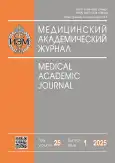Особенности определения степени тяжести состояния пострадавших, подвергшихся воздействию химического фактора пожара
- Авторы: Толкач П.Г.1, Кузнецов О.А.2, Анохин Д.Ю.1, Лодягин А.Н.2, Гайдук С.В.1, Башарин В.А.1
-
Учреждения:
- Военно-медицинская академия имени С.М. Кирова
- Санкт-Петербургский научно-исследовательский институт скорой помощи имени И.И. Джанелидзе
- Выпуск: Том 25, № 1 (2025)
- Страницы: 24-30
- Раздел: Клинические исследования и практика
- URL: https://journal-vniispk.ru/MAJ/article/view/312075
- DOI: https://doi.org/10.17816/MAJ546142
- EDN: https://elibrary.ru/QZYTFY
- ID: 312075
Цитировать
Аннотация
Обоснование. Для определения степени тяжести состояния пострадавших, подвергшихся воздействию химического фактора пожара, ориентируются на содержание карбоксигемоглобина в крови. Ингаляционное воздействие продуктов горения полимерных материалов, обладающих пульмонотоксическим действием, приводит к нарушению структуры и функции дыхательной системы, что играет важную роль в утяжелении состояния пострадавших и прогнозировании исхода.
Цель — выявить особенности определения степени тяжести состояния пострадавших, подвергшихся воздействию химического фактора пожара, в зависимости от рассчитанной начальной концентрации карбоксигемоглобина в крови и наличия интерстициальных изменений в тканях легких.
Материалы и методы. При проведении ретроспективного анализа историй болезней пострадавших, подвергшихся воздействию химического фактора пожара, рассчитывали начальную концентрацию карбоксигемоглобина в крови, анализировали рентгенограммы органов грудной полости, выполненные в первые сутки после поступления.
Результаты. В зависимости от рассчитанной начальной концентрации карбоксигемоглобина в крови выделили пациентов тяжелой (59 [55; 60]%), средней (42 [36; 43]%) и легкой степени (18 [15; 24]%) тяжести. Длительность госпитализации пациентов не зависела от степени тяжести. Длительность госпитализации (5 [4; 8] сут) пациентов с выявленными на рентгенограммах интерстициальными изменениями в легких (47 ± 7% пострадавших) была выше (p = 0,03) по сравнению (3 [2; 5] сут) с пациентами, у которых интерстициальных изменений выявлено не было (53 ± 7% пострадавших). Определили умеренную корреляцию (r = 0,31, p < 0,05) между длительностью госпитализации пациентов и наличием интерстициальных изменений со стороны дыхательной системы.
Заключение. Наличие интерстициальных изменений в тканях легких, определенных при проведении рентгенографии, следует рассматривать в качестве неблагоприятного прогностического признака и учитывать при организации оказания медицинской помощи пострадавшим, подвергшимся воздействию химического фактора пожара.
Полный текст
Открыть статью на сайте журналаОб авторах
Павел Геннадьевич Толкач
Военно-медицинская академия имени С.М. Кирова
Автор, ответственный за переписку.
Email: pusher6@yandex.ru
ORCID iD: 0000-0001-5013-2923
д-р мед. наук, заместитель начальника кафедры военной токсикологии и медицинской защиты
Россия, Санкт-ПетербургОлег Анатольевич Кузнецов
Санкт-Петербургский научно-исследовательский институт скорой помощи имени И.И. Джанелидзе
Email: kuznetcov_dr@inbox.ru
ORCID iD: 0000-0002-1275-9570
SPIN-код: 4656-5700
канд. мед. наук, заведующий отделением токсикологической реанимации
Россия, Санкт-ПетербургДмитрий Юрьевич Анохин
Военно-медицинская академия имени С.М. Кирова
Email: damixon@mail.ru
ORCID iD: 0000-0003-4499-066X
SPIN-код: 6186-5543
канд. мед. наук, преподаватель кафедры рентгенологии и радиологии с курсом ультразвуковой диагностики
Россия, Санкт-ПетербургАлексей Николаевич Лодягин
Санкт-Петербургский научно-исследовательский институт скорой помощи имени И.И. Джанелидзе
Email: alodyagin@mail.ru
ORCID iD: 0000-0002-8672-2906
SPIN-код: 4886-8890
д-р мед. наук, доцент, заведующий центром токсикологии
Россия, Санкт-ПетербургСергей Валентинович Гайдук
Военно-медицинская академия имени С.М. Кирова
Email: gaiduksergey@mail.ru
ORCID iD: 0000-0003-1524-9493
SPIN-код: 8602-4922
д-р мед. наук, доцент, заместитель начальника кафедры военно-полевой терапии
Россия, Санкт-ПетербургВадим Александрович Башарин
Военно-медицинская академия имени С.М. Кирова
Email: basharin1@mail.ru
ORCID iD: 0000-0001-8548-6836
SPIN-код: 4671-8386
д-р мед. наук, профессор, начальник кафедры военной токсикологии и медицинской защиты
Россия, Санкт-ПетербургСписок литературы
- Толкач П.Г., Лодягин А.Н., Башарин В.А., и др. Анализ структуры пострадавших на пожаре в Санкт-Петербурге и Ленинградской области в 2021 году // Медлайн.ру. 2023. Т. 24, № 49. С. 667–675. EDN: QQOGPY
- Мадорский С. Термическое разложение органических полимеров: пер. с англ. / под. ред. С.Р. Рафикова. Москва: Мир, 1967. 328 с.
- Сагин П. Теплоизоляция из пенополиуретана – инновационный утеплитель или химическиопасный материал? // Кровельные и изоляционные материалы. 2014. № 4. С. 18–19. EDN: THVGQZ
- Федеральные клинические рекомендации. Токсическое действие окиси углерода. Токсическое действие других газов, дымов и паров. 2020.
- Башарин В.А., Чепур С.В., Толкач П.Г., и др. Токсикология продуктов горения полимерных материалов: учебное пособие. Санкт-Петербург: Левша, 2022. 104 с.
- Отравление монооксидом углерода (угарным газом) / под ред. Ю.В. Зобнина. Санкт-Петербург: Тактик-Студио, 2011. 79 с.
- Hampson N.B., Hauff N.M. Carboxyhemoglobin levels in carbon monoxide poisoning: do they correlate with the clinical picture? // Am J Emerg Med. 2008. Vol. 26, N 6. P. 665–669. doi: 10.1016/j.ajem.2007.10.005
- Александров Н.П. Выбор экспериментальных животных для разработки нормативов окиси углерода // Гигиена и санитария. 1973. Т. 38, № 1. C. 92–95.
- Тришкин Д.В., Чепур С.В., Башарин В.А., и др. Пульмонотоксичность продуктов горения синтетических полимеров // Сибирский научный медицинский журнал. 2018. Т. 38, № 4. С. 114–120. EDN: XWBYQH doi: 10.15372/SSMJ20180415
Дополнительные файлы








